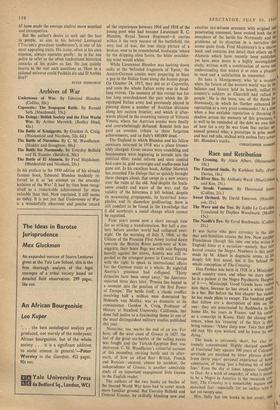Race and Retribution
The Fractured Smile. By Kathleen Sully. (Peter Davies, 18s.) The Strode Venturer. By Hammond Innes' (Collins, 21s.)
The Needle's Eye. By Errol Brathwaite. (Collins, 21s.) IT was Sartre who gave currency to the idea that anti-Semitism creates the Jew. Now another Frenchman (though this time one who writes in English) hints at a variation—namely, that race hatred creates the Negro. Nowhere is this point made by M. Albert in dogmatic terms, in ills deeply felt first novel, but it lies behind the whole conception of The Crossing. Dan Peebles was born in 1928 in a MississiPPt small country town, and when the story oPene, he is a patient at the Negro Psychiatric Hospital, of J---, Mississippi. Good friends have rushee him there, because he has struck a white youth in a bar. But before the first chapter has ended, he has made plans to escape. The hundred pages that follow are a description of him on the run: they are punctuated by flashbacks to his home life, his years in France, and his career as a conscript in Korea. Only the closing serr tences, when his 'crossing' of the Styx is due' t',
bring release: `Ahma sleep now. Take that go
old nap. His eyes winked, and he knew he v0 dying.'
The book is extremely short, but also eX" tremely concentrated. Highly charged speeches, of frustrated fury against 300 years' of Coloured servitude are matched by bitter phrases drawn from thirty years' personal experience of bein,,g submissive, of being 'just a burning bit of WO', fear.' Even the sky at times appears ironharcl to Dan. As a work of empathy, of what it means to be a Negro in America in the twentieth cell; tury, The Crossing is a remarkably mature and sustained feat—especially for an author who Is
not yet twenty-one. books to her credit, and Mrs. Sully has ten
many of the distinguished characteristics which marked earlier ones reappear in The Fractured S'nile. Jess Smith's husband is in the habit of going off with other women and when she hears that this has happened once again, she decides to Pursue him with her seven-year-old son and a revolver which she takes from the attic. She has no intention of shooting-only of scaring 11611 for even the crack of a car backfiring would cause him to worry and fret.'
, Her plans, however, miscarry when they reach the sea at Southcombe, because on the sands her son plays with another boy, who by mistake picks up the bag with the revolver in it. When he opens it, he thinks it simply a toy gun, puts '1 back in the bag and slings it over his shoulder. The two boys are much more concerned with finding food for a stray dog which has attached follows to them, and wander off. The hunt that lollows them along the promenade, and then into the town, resembles a summer har]equinade, and shows Mrs. Sully at her best. She is able to bring together her familiar mixture of slap- stick and sadness and to present the crook with a letlectuing trait-in this case, a bank robber who Is prepared to risk his own skin, in a search for two lost boys, a dog and a gun.
In The River Slea, George Gilbert, just in his twenties, proves to be his own worst enemy. His girl-friend finds that he may hit her savagely with a stick one moment, and the next kiss her. 'You must not let him bully you,' warns his mother. The cause of this schizophrenia is put down to resentment at the memory of a tougher elder brother who was killed five years before in a Motor-bike crash. This is Mr. Ward's second VolUnne in a projected trilogy, and the best parts are those where he writes as a naturalist and describes the Lincolnshire countryside: . . . in April . . . green blades of corn separate against the brown soil. The leaves on the haw- thorn hedges are still small enough for the wood they grow from to be seen. There is water about. The cloud is cumulous. The weather is fitful, strong and vigorous.
Mr. Hammond Innes is a master of suspense. In his latest book The Strode Venturer there are captains hired to go on mysterious voyages, as well as islands that suddenly appear (and just as suddenly seem to disappear) in the Indian Ocean. The writing is immensely professional, and the contrast between the pirates in the City world of takeover bids and the real adventurers with a sense of mission in the Far East is put across with an authenticity that suggests first- hand observation. There are all the elements here for a film of high drama and exciting scenic effects: 'The ship, with her steel bottom firmly stranded on the sea bed, was earthed; she was' acting as a huge lightning conductor.'
Sweet Orchard and The Wave and the Toy are both romance stories. Mr. Emerson sets the first near Bath in the 1830s and traces the stormy course of a local baronet's son in and out of love, while in the second Mlle i.e Grdvellec follows the first fiutterings in the heart of a girl of seventeen. The latter is well translated by Daphne Woodward, and both books are suited to idling away a summer afternoon. Not much more. • The Needle's Eye is the second volume of a New Zealand trilogy by Mr. Brathwaite. It is set in the nineteenth century and deals with the Maori wars and the. constant tattoo of Colonial hooves. It is a work that is at once both serious and full of adventure, and will appeal to boys from nine to ninety.
NEVILLE BRAYDROOKE





























 Previous page
Previous page